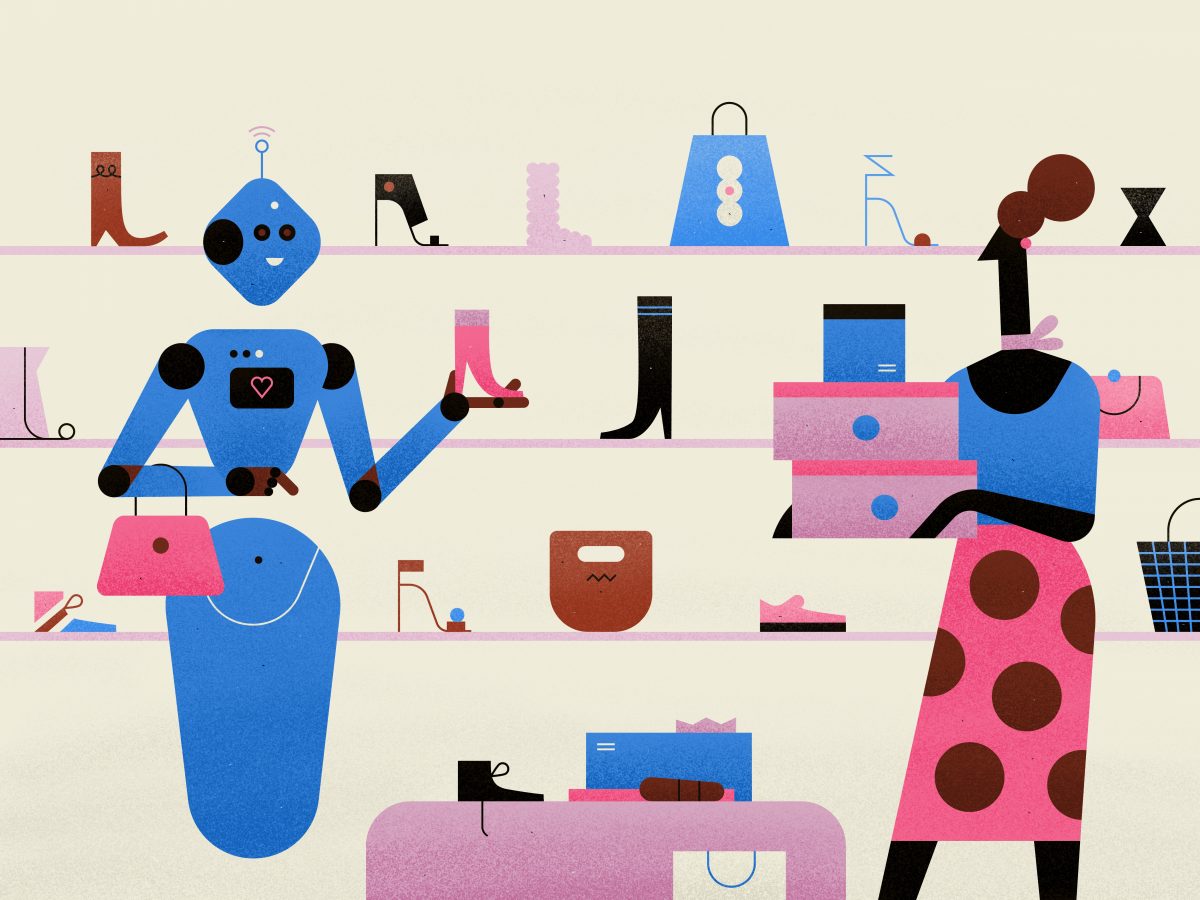
Science fiction author William Gibson coined the term ‘cyberspace’ in his 1984 novel Neuromancer to describe an imagined internet-based virtual world. His idea was like the internet of things (IoT) we have today, but he didn’t foresee its kooky yet useful features – like replacement ordering coffee capsules or printer ink cartridges – which, banal as they are, have the retail sector aflutter imagining how to serve its new non-human consumers.
The network of internet-connected ‘smart’ devices is growing fast and infiltrating many parts of life. Market intelligence firm IDC projects there’ll be 55.7 billion internet-connected devices worldwide by 2025. This is just the beginning. Gibson pointed to the future of artificial intelligence needing human sensibility to be more ‘intelligent’ and so, useful. It’s not long since smart fridges were considered expensive Proofs of Concept with little added value for the consumer. But that view changed as costs fell and technology adapted to show its usefulness.
Should we expect more devices like printers and fridges with sensors to make inventories, monitor supplies and replenish them automatically? Futurist Matthew Griffin from 311 Institute thinks so. “We’ve already seen fridges that have cameras and AI machine vision. They know what’s in the fridge and can reorder things through your favorite online shop. HP printers monitor ink levels and order replenishments,” he said.
But we also live in a time when some tech advances have moved away from regulatory and social boundaries detrimentally. We’re playing catch-up in areas like privacy regulation and limiting the spread of misinformation on social media, and living with the consequences of unrestrained, fast-moving innovation.

Retail cybersecurity
Kaspersky retail cybersecurity
Securing POS terminals, workstations mobile devices and back-office systems, designed for retail needs.
For Griffin, there are big security and privacy implications of letting IoT devices act like humans. “Every aspect of your life will be watched and monitored by systems that monitor your behavior around the house by listening to cues,” he says. “In short, your privacy is non-existent — which is where regulators come in.”
Kaspersky’s Senior Security Researcher Dan Demeter believes it’s crucial IoT makers and sellers do their part by securing devices. “The kinds of steps they must take include regularly auditing source code and black box testing. Having a bug bounty program lets makers take advantage of cybersecurity vulnerability researchers out there looking for rewards. Regular ‘red team’ testing (also known as ethical hacking) is important nowadays because supply chain attacks are becoming so common.” He goes on to say, “If you find a vulnerability, make it easy for customers to patch their devices. Don’t have ‘vendor backdoors’ on your IoT devices, but let users run and manage them on closed networks. Make sure the device’s operating system is secure and make default logins and passwords unique and hard to crack.”
Satisfying the smart device customer
Smart devices are already customers. Amazon’s digital assistant Alexa acts as an ecommerce assistant, as do car ‘infotainment’ systems and a growing number of smart appliances. Siri and Google Assistant are moving in the same direction.
These devices can authenticate the speaker’s identity with one word, understand vague instructions like “tell me where my orders are” and recommend things based on your location or past purchases.
Samsung fridges can already order from third-party suppliers, but it won’t end there. Griffin sees a future when a manufacturer like Samsung creates smart fridges that order replacement groceries from a Samsung-owned store. “These new ‘customers’ let companies create new business models and revenue streams,” says Griffin. “If one million fridges needed milk, they could form buying consortiums using blockchain and hold an e-auction to get the best deal. Then they could take the money they save their owners and put it in a bank account to help owners save for a holiday, or even invest it.”
Retailers will think of smart devices and appliances as we do smartphones, where an Apple iPhone must buy apps from the Apple app store. Griffin continues, “It’ll be the same with other smart devices — if you want to buy X, their device is connected to their store.”
Privacy concerns, unfamiliarity with and distrust of ‘smart’ services and lack of standards for consistency across applications and brands will temper IoT-market growth. But Dan Miller, Lead Analyst and Founder of Opus Research, is optimistic. “While they rightfully raise privacy concerns, they are key to providing secure and personalized digital ecommerce assistants. A lot of these issues can be overcome in short order.”
Miller goes on to say, “Expect voice assistance to be integrated into kitchen appliances as well as TV remotes and smart speakers where they’re already used to order new entertainment content,” says Miller.
Miller predicts next we’ll see digital assistants develop into voice agents aware of people’s purchasing patterns, payment preferences and preferred sellers. “Voice brings the added advantage of being a biometric signature and key to personalization.”
Retailers look to IoT data for personalization
There’s a roll call of ways IoT will change retail and ecommerce. It promises many ways to improve transactions, systems and processes. For retail, stock availability and order fulfillment can become more transparent and responsive in real-time, giving confidence consumers can find and buy what they want when they want it.
For wholesale and manufacturing, managing stock levels, ordering and production will be easier through real-time analytics. Connecting with retailers will enhance supply chains by reducing system holdups.
Connected household devices like fridges and printers bring manufacturers closer to their end-user, giving valuable real-world usage data and new ways to communicate with customers.
Remote device monitoring will mean valuable intelligence for predictive maintenance based on time and usage and performance analytics from day-to-day usage.
Personalized offers based on first-hand customer intelligence could build loyalty and brand connection. ‘Frictionless’ stores like Amazon Go already let consumers select goods in an IoT-connected store then pay with smart devices without scanning and check out. IoT ecommerce will go further as devices themselves monitor usage and buy replacement supplies.
David Dubois, Associate Professor of Marketing at graduate business school INSEAD, specializes in understanding how to turn data-led insights from digital technologies like IoT, AI and blockchain into commercial intelligence. “IoT devices can make every product ‘alive’ by capturing a continuous flow of data reflecting its use and the state of the machine the device is in,” he says
He believes IoT devices can prevent maintenance issues like waiting for repairs to machines or reordering coffee capsules. But more importantly, he says their data is a strategic tool for companies to expand into new services, products and competitive space.
“By monitoring running information, Nike gets information on things beyond its point of interest. It can, for instance, collect data on heart rate tied to stress and sleeping patterns and expand by rolling out new solutions in these spaces,” Dubois says.
Will algorithms eventually shop for humans?
As more IoT devices make buying decisions, like the printer that monitors and reorders paper and ink, could these internet-connected devices eventually act like customers?
Retail futurist Howard Saunders thinks we’re entering a time when algorithms, artificial intelligence (AI) and IoT will collude to remove friction from our lives, like the chore of replenishment. “We’re witnessing the crystallization of the difference between ‘retail’ and ‘shopping,'” Saunders says.
He continues, “Retail has grown to encompass everything online – hospitality, banking, museums – but people want to know if there’s a future for ‘shopping’ in a world that faces the relentless march of AI and the algorithms. That’s shopping in the sense of heading out for a day’s browsing, meeting and trying on that happens in our town centers and malls. My answer is an emphatic YES!”
Saunders’ vision of the future high street will excite many. “As routine replenishment is taken away from us, real-world shopping will become more engaging. From corner shop deli tastings and bakery workshops to big brand playgrounds in urban centers, shopping is becoming less about getting stuff and more about experiencing things. It’s already happening. Shops that just sold things are dying while young brands with something to say are taking their places. I say bring it on.”
Smart devices are increasingly behaving like consumers, from making recommendations based on past buying to replenishing supplies. Retail brands must plan to adapt to this new kind of customer while realizing people will still want experiences retail can provide. IoT manufacturers and suppliers can lead the way in consumer trust by upholding customer privacy and securing their devices well.



